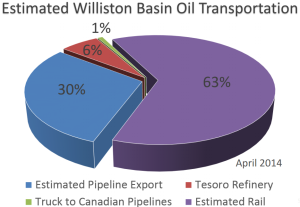ND rail shipments peak; pipelines set to take over oil load

By Rob Port | Watchdog.org North Dakota Bureau
SHIPPING SHIFT: This graphic prepared for the North Dakota Legislature by the state’s Pipeline Authority shows rail dominating other forms of transportation for oil shipments in the state. But a change is coming. Rail’s percentage is down from 75 percent a year ago, and pipeline capacity is scheduled to double by the end of 2016.
BISMARCK, N.D. — Rail shipments from the booming oil fields in North Dakota have sparked national headlines and a debate over safety, after several high-profile derailments.
But it appears as though rail shipments of crude oil have peaked as pipeline capacity sets to expand.
In July 2013, a 74-car train carrying Bakken crude oil derailed in Quebec, Canada, exploding and killing 47 people. In December, 18 tanker cars carrying Bakken crude oil derailed near Casselton and exploded, leading to an evacuation of the city. Some experts claim Bakken crude oil is more volatile than other types of oil and are calling for improved tanker car safety and a requirement that the oil be processed before shipping, to make it less volatile.
The oil industry has pushed back against these claims. “There is nothing wrong with the crude oil” in the Bakken, Jeff Hume vice chairman of Continental Resources, told the Wall Street Journal in June. “It does not need stabilization.”
But as the debate over rail safety intensifies, pipelines seem set to supplant tanker cars as the primary means of oil shipments out of North Dakota.
According to numbers prepared by the North Dakota Pipeline Authority and presented to the Legislature’s interim Energy Development and Transmission Committee, 63 percent of the oil produced in the state in April was shipped by rail. That’s down from a peak of 75 percent in April 2013.
Meanwhile, the state is will see a big expansion in pipeline capacity as new projects come online.
In June, Gov. Jack Dalrymple, a Republican, announced the state’s oil pipeline capacity would exceed 783,000 barrels per day by the end of 2014, a 173 percent increase over the state’s 286,000 barrels per day capacity in 2009.
It appears as though that goal will be a reality.
Two major pipeline projects — the Butte Loop and the Hiland Double H — capable of taking a combined 160,000 barrels per day of oil to Guernsey, Wyo., are scheduled to be in service later this year. In May, the Plains Bakken North pipeline went online, taking 40,000 barrels per day to Canada.
In April, the state produced just more than 1 million barrels of oil per day, according to the Industrial Commission’s Department of Mineral Resources. With production still growing, Dalrymple has predicted that the state’s pipeline capacity will hit “about 1.4 million barrels per day” by the end of 2016.
That prediction, too, seems set to come true.
The Sandpiper, Enterprise and Energy Transfer Partners pipelines — taking oil to Superior, Wisconsin, Cushing, Oklahoma and Potoka, Ill., respectively — are scheduled to be in-service in 2016, representing another 795,000 barrels per day of capacity.
The Keystone XL pipeline could potentially take 100,000 barrels per day of oil out of the state, but approval for that project has become the focus of a national political battle between the Obama administration and a coalition of Republicans and Democrats in Congress, making the project’s timeline unknown.







